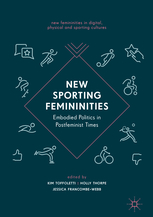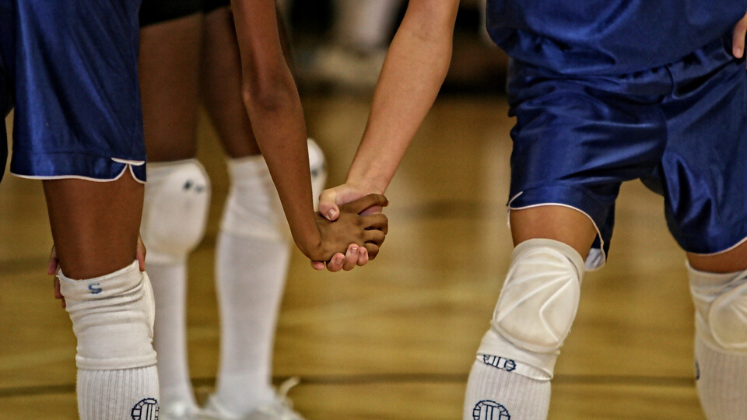In New Sporting Femininities: Embodied Politics in Postfeminist Times, Kim Toffoletti, Holly Thorpe and Jessica Francombe-Webb bring together contributors to explore how sporting femininities have been shaped by a postfeminist context, tracking changing gendered power relations in sport and physical cultures alongside new forms of inequality and sexism. This collection is a refreshing and comprehensive look at postfeminism, sporting femininities and physical activity, writes Meltem Ince-Yenilmez, and contributes towards building a more equal playing field in the world of sports for everyone.
New Sporting Femininities: Embodied Politics in Postfeminist Times. Kim Toffoletti, Holly Thorpe and Jessica Francombe-Webb (eds). Palgrave. 2018.
 New Sporting Femininities explores ‘the changing nature of gendered sporting subjectivities, bodies, practices, politics, agency and experiences’ and argues that new femininities have emerged in the era of postfeminism explored in the collection. New Sporting Femininities opens with editors Kim Toffoletti, Holly Thorpe and Jessica Francombe-Webb looking at the evolving view of gender politics in sport and physical cultures in local and global contexts. The authors examine the various ways in which sporting femininities may have been shaped by a decisive postfeminist moment, which the contributing authors define and view through different lenses. But one thing is made clear:
New Sporting Femininities explores ‘the changing nature of gendered sporting subjectivities, bodies, practices, politics, agency and experiences’ and argues that new femininities have emerged in the era of postfeminism explored in the collection. New Sporting Femininities opens with editors Kim Toffoletti, Holly Thorpe and Jessica Francombe-Webb looking at the evolving view of gender politics in sport and physical cultures in local and global contexts. The authors examine the various ways in which sporting femininities may have been shaped by a decisive postfeminist moment, which the contributing authors define and view through different lenses. But one thing is made clear:
postfeminism does not simply stand for the rejection of feminism or a period after feminism, but constitutes a distinctive cultural condition that invites and produces new articulations of femininity.
In evaluating the contributions to New Sporting Femininities, it comes to mind that there have been many neoliberal currents and feminist assumptions shaping our contemporary moment, which have in turn created a dynamic environment to accommodate the changing landscape in sports when it comes to women, girls, people of colour, LGBTQ+ people, disabled athletes, individuals with limited financial capacities and others. The purpose of these fresh insights is to evaluate the influence of gendered power relations in sport and physical cultures alongside the new forms of inequality and sexism in this present era.
In this book, contributors use the concept of postfeminism to provide a categorical analysis rather than present one perspective. The editors critically analyse the concept of postfeminism to designate the specific cultural conditions necessary for new assumptions about femininity, as postfeminist sentiments shape the way gendered subjectivities are enacted and inform how contemporary gender relations are understood. The central themes of postfeminism are the independence of women, the expression of femininity in terms of physical attributes, an emphasis on how women care for their bodies and a fixation on expressions of heterosexual femininity. The book also highlights how freedom of choice is crucial to how we conceive equality in the postfeminist context.
There is utility in an engagement with postfeminism as a means to understand women’s contemporary embodied experiences in different cultural contexts. In addition, postfeminism can increase understanding of the globalised, flexible and self-actualising representations of women in contemporary sport and physical cultures. However, according to the editors, despite the growing trend of postfeminism, the concept has rarely been brought to the fore as part of feminist analysis of sport and physical cultures. Despite women’s accomplishments in the world of sports, there is also a looming gap because these stories often fail to focus on how women and girls in diverse contexts live active or inactive lives. Analyses also do not pay enough attention to other parameters, such as age, ethnicity, religion, sexuality and class.

Image Credit:
As a result, the book takes a comprehensive approach to studying the different ways groups of girls and women build meaningful connections in the context of sport and physical cultures. The sections in the book consequently spin around different subjects and fields, such as sociology, communication and media studies, cultural studies as well as sporting and physical health education. The way this book intertwines various disciplines will serve as a point of interest to a broad spectrum of experts and students from undergraduate level upwards. A wide range of sports and topics are also covered in this book, from the National Football League (NFL) to board sports, such as skateboarding and skiing, through to the ‘Fitspo’ hashtag, sports media and sportswear. Furthermore, the collection provides insights on how the concepts of participation, women’s autonomy, freedom of choice and empowerment have distinctive meanings across the neoliberal market and global sports industry.
Across three sections, the book deals with different aspects of sporting femininities under the cultural conditions of postfeminism. The first section, ‘Post-Feminism and the Sports-Media Industrial Complex’, highlights five main scenarios to evaluate various representations of women in sport, ranging from a team of ‘football widows’ (referring to women whose male partners frequently play or watch football) to the tennis giant, Serena Williams. In this latter chapter, the way the sports media portrays Williams is evaluated with emphasis on how understandings of race and femininity influence the image formed by the sporting media.
Another chapter deals with the portrayal of the Muslim-American athletes Ibtihaj Muhammad, a sabre fencer, and Dalilah Muhammad, a track and field athlete specialising in the 400 metres hurdles. They both rose to prominence at the 2016 Rio Olympics, winning bronze and gold medals respectively. This occasion of their landmark achievements occurred at around the same time as Donald Trump was kickstarting his presidential campaign fraught with hostility towards minorities in the US. In discussing this train of events, Sumaya F. Sammie and Toffoletti bring to the fore how this ‘coexistence of competing discourse’ pertaining to Muslim women is propagated in the US media. The first view portrays Muslim women as passive and relegated to the background due to their religious affiliations that are seen to go against Western sentiments; as a result, they are deemed ‘Other’. The second view portrays Muslim women as complex, active agents capable of bringing about social and political change. Media representations tend to be more welcoming of Muslim women if they adopt more ‘Western’ modes of femininity. This goes to show that neoliberal postfeminist sentiments have been employed by the US media when determining which bodies of Muslim women are deemed ’empowered’ or not.
The second section, ‘Everyday Athletic Girls and Women Negotiating Post-Feminism’, uses three different scenarios to emphasis the embodied experience of physical activity. The chapters in this part illuminate how engaging in sporting activities can lead to the questioning of gender conventions in three dissimilar circumstances, while taking into account the established norms assigned to gender in different contexts. Adele Pavlidis turns her attention to roller derby in China. She digs deeper into how this sport has in recent times turned into an emblem of feminism, although this contains risk as the sport was imported into Chinese culture with development goals in mind.
Laura Azzarito looks at how whiteness has been associated with a particular type of feminine model that is seen to have the attributes of a healthy-looking body: the image of a kind of ‘superwoman’ without failings or struggles that has been widely spread in the media. Relying on data gathered from a survey of young African-American and Latina girls, Azzarito explains how the media has painted a picture of a youthful-looking, ageless body that is white, slender and full of confidence. This causes a crisis of confidence among these young girls who are unable to recognise themselves in this imagery, bringing about feelings of exclusion.
The third and final section, titled ‘Post-Feminism in Online Sports and Fitness Spaces’, highlights how women’s sport is portrayed in digital worlds. This section discusses the images created online by disabled women athletes as well as queer activism centred on social media. It also addresses the current use of sports in global aid work, with Thorpe et al sharing insights on the ‘Skateistan’ organisation that teaches skateboarding to Afghan girls to illustrate affirmative portrayals of sporting women in the Global South. Citing various examples, the chapters in this section suggest that digital environments can offer positive online images because women have the capacity to tweak and construct their own images of partaking full-time in sporting activities.
By focusing on ‘sporting femininities’, these contributions analyse the concept of femininity in society and the world of sports while opening up further questions for binary gender models that exclude other identifications, such as trans, queer and non-binary. These questions have urgency for the world of competitive sport due to its extremely gender-divided structure, but are also important in amateur sporting events. Within the framework of postfeminism, this has also produced an ideal image of ‘successful’ femininity, which becomes an imperative for women to relate to and against which all women’s bodies are examined and assessed. This idealised image in the world of sport means that the athletic and the feminine still often end up on a collision course with each other.
This volume presents a unique set of refreshing and comprehensive issues when studying postfeminism, sporting femininities and physical activity. New Sporting Femininities encourages more in-depth analysis of the cultural, political, social and economic conditions influencing the postfeminist era. It offers fresh perspectives and new interventions to help build a more equal and level playing field in the world of sports for everyone, regardless of their gender, race, religion, ethnicity, health status, sexuality or nationality.
Note: This review gives the views of the author, and not the position of the LSE Review of Books blog, or of the London School of Economics.







